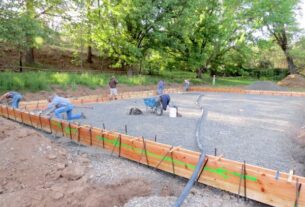Shoreline protection is a critical aspect of coastal management, especially in areas prone to erosion and flooding. One of the widely used methods for shoreline protection is rock revetment construction. Rock revetments are sloping structures made of durable rocks or concrete blocks placed along the shoreline to absorb and deflect the energy of incoming waves, thereby reducing erosion and protecting coastal properties. This article explores the importance of rock revetment construction in shoreline protection and why it is a preferred choice in many coastal engineering projects.
1. Erosion Control
One of the primary reasons for doing rock revetment construction in shoreline protection is their effectiveness in controlling erosion. Waves generated by storms and tides can erode coastal areas, leading to the loss of land and damage to infrastructure. Rock revetments act as a barrier against wave action, absorbing the energy of the waves and reducing their erosive force. By dissipating wave energy, rock revetments help stabilize the shoreline and prevent further erosion, ultimately protecting coastal properties and habitats.
2. Longevity and Durability
Rock revetments are known for their longevity and durability compared to other shoreline protection methods. When properly designed and constructed, rock revetments can withstand harsh environmental conditions, including strong wave action, high tides, and storm surges. The use of durable rocks or concrete blocks ensures that the revetment remains intact over an extended period, providing continuous protection to the shoreline. This longevity makes rock revetments a cost-effective solution in the long run, as they require minimal maintenance and have a longer lifespan compared to other erosion control measures.

3. Natural Aesthetic
Another advantage of rock revetments is their natural aesthetic appeal. Unlike seawalls or other hard structures that can disrupt the visual continuity of the coastline, rock revetments blend in with the natural environment. The use of locally sourced rocks or materials in revetment construction helps maintain the coastal aesthetics while providing essential shoreline protection. Rock revetments can enhance the beauty of the coastline, creating a more visually appealing and ecologically sensitive shoreline management solution.
4. Habitat Enhancement
Rock revetments can also serve as habitat enhancement structures, promoting biodiversity along the shoreline. The interstitial spaces between rocks in the revetment can create microhabitats for various marine organisms, including algae, barnacles, and mollusks. These organisms, in turn, attract fish and other marine species, contributing to the overall ecological health of the coastal area. By mimicking natural rocky shore environments, rock revetments can support the establishment of diverse habitats and help restore ecosystem functions in areas where natural habitats may have been disrupted.

5. Climate Resilience
In the face of climate change and sea-level rise, the importance of resilient shoreline protection measures cannot be overstated. Rock revetments have proven to be effective in enhancing the resilience of coastal areas against the impacts of climate change. By reducing erosion, absorbing wave energy, and stabilizing shorelines, rock revetments help mitigate the risks associated with coastal hazards such as storm surges and flooding. Incorporating rock revetments as part of a comprehensive coastal management strategy can improve the climate resilience of coastal communities and infrastructure.
Conclusion
In conclusion, rock revetment construction plays a crucial role in shoreline protection by providing erosion control, longevity, natural aesthetic, habitat enhancement, and climate resilience. As coastal areas face increasing threats from erosion, storms, and sea-level rise, the importance of implementing sustainable and effective shoreline protection measures becomes paramount. Rock revetments offer a versatile solution that combines engineering functionality with ecological sensitivity, making them a preferred choice for many coastal engineering projects. By understanding the importance of rock revetments in shoreline protection, we can work towards creating more resilient and sustainable coastal environments for future generations.
Stay in touch to get more updates & news on speromagazine.com




